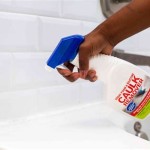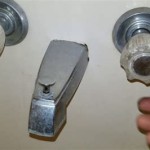Spout Cover For Bathtub Faucet: A Comprehensive Guide
A spout cover for a bathtub faucet is a safety accessory designed to protect children from injuries caused by accidental bumps or falls against the hard metal faucet. These covers are typically made from soft, impact-absorbing materials like foam or silicone and come in various shapes, sizes, and designs to fit different faucet types. The primary function of a spout cover is to cushion the impact, minimizing the risk of head injuries or other physical harm. Beyond safety, some spout covers offer additional features such as temperature indicators or integrated bath toys.
The selection of a suitable spout cover is an important decision for many parents or caregivers. A well-chosen cover can provide peace of mind during bath time, allowing for a more relaxed and enjoyable experience for both the child and the adult. However, with a wide array of options available, understanding the different types, materials, and features is crucial for making an informed choice.
Types of Spout Covers
Spout covers are categorized based on their design, material, and attachment method. Understanding these categories helps in choosing the right cover for a specific bathtub faucet and the needs of the child.
Foam Spout Covers: These are typically the most affordable and readily available type. They are usually made of dense foam that provides cushioning. Foam spout covers are lightweight and easy to install. However, they may not be as durable as other types and can be susceptible to tearing or degradation over time, particularly with repeated exposure to water and cleaning products. They also may not fit all faucet designs securely.
Silicone Spout Covers: Silicone covers offer a more durable and often more aesthetically pleasing option. Silicone is waterproof, resistant to mold and mildew, and relatively easy to clean. These covers tend to be more flexible than foam covers, allowing for a better fit on a wider range of faucet designs. Silicone spout covers can also incorporate features such as temperature indicators that change color based on water temperature, providing an additional safety measure. Some silicone covers are designed with drain holes to prevent water from pooling inside, which can contribute to mold growth.
Inflatable Spout Covers: While less common, inflatable spout covers offer a unique combination of cushioning and portability. They are typically deflated when not in use, making them easy to store or transport. When inflated, they provide a soft barrier around the faucet. However, inflatable covers may be more prone to punctures and require periodic reinflation. Their overall durability may be lower compared to foam or silicone options.
Hard Plastic Spout Covers with Padding: These covers consist of a rigid plastic shell with a soft inner lining, typically made of foam or silicone. The hard plastic shell provides structural support and helps to maintain the shape of the cover, while the padding cushions the faucet. These covers often have secure attachment mechanisms, such as straps or suction cups, to prevent them from slipping off the faucet. While offering good protection, they might be bulkier than other types.
Key Considerations When Choosing a Spout Cover
Selecting the appropriate spout cover requires careful consideration of several factors, including the faucet design, the child's age and developmental stage, and the features offered by different models.
Faucet Compatibility: Not all spout covers are compatible with all faucet designs. Some faucets have unique shapes or sizes that may prevent certain covers from fitting securely. It is crucial to measure the dimensions of the faucet and compare them to the specifications of the spout cover before making a purchase. Covers with adjustable straps or flexible materials are more likely to fit a wider range of faucet types. Covers that rely solely on friction for attachment may not be suitable for faucets with unusual shapes or slippery surfaces.
Material Safety: When selecting a spout cover, ensure that it is made from non-toxic materials that are safe for children. Look for products that are BPA-free, phthalate-free, and lead-free. These chemicals can leach out of the plastic and pose health risks to children. Check for certifications from reputable organizations that verify the safety of the materials used in the cover. Regularly inspect the cover for any signs of wear, tear, or degradation, and replace it if necessary.
Secure Attachment: A spout cover is only effective if it stays securely attached to the faucet. Covers that easily slip off can pose a choking hazard or fail to provide adequate protection in the event of a fall. Look for covers with secure attachment mechanisms, such as adjustable straps, suction cups, or locking mechanisms. Test the attachment of the cover before each use to ensure that it is firmly in place. Regularly check the suction cups or straps for signs of wear or damage and replace the cover if necessary.
Ease of Cleaning: Spout covers can accumulate soap scum, mold, and mildew over time. Choosing a cover that is easy to clean is essential for maintaining hygiene and preventing the growth of harmful bacteria. Silicone covers are generally easier to clean than foam covers because they are non-porous and resistant to moisture. Look for covers that can be easily wiped down with a damp cloth or dish soap. Some covers are dishwasher-safe, which can simplify the cleaning process.
Additional Features: Some spout covers offer additional features that can enhance their functionality. Temperature indicators, for example, can alert parents to dangerously hot water temperatures, reducing the risk of scalding. Some covers also incorporate bath toys or bubble makers, which can make bath time more enjoyable for children. Consider whether these additional features are important to the child's bath time routine when choosing a spout cover. However, prioritize safety and functionality over purely aesthetic features.
Installation and Maintenance of Spout Covers
Proper installation and regular maintenance are essential for ensuring that the spout cover provides adequate protection and remains hygienic.
Installation Procedure: Follow the manufacturer's instructions carefully when installing the spout cover. Ensure that the cover is properly aligned with the faucet and that all attachment mechanisms are securely fastened. For covers with straps, adjust the straps to create a snug fit around the faucet. For covers with suction cups, ensure that the suction cups are clean and firmly pressed against a smooth, non-porous surface. Test the attachment of the cover by gently pulling on it to ensure that it does not slip off easily.
Regular Cleaning: Clean the spout cover regularly to prevent the buildup of soap scum, mold, and mildew. Wipe down the cover with a damp cloth or sponge after each use. For more thorough cleaning, remove the cover and wash it with warm water and dish soap. Rinse the cover thoroughly and allow it to air dry completely before reattaching it to the faucet. Avoid using harsh chemicals or abrasive cleaners, as these can damage the cover. If the cover becomes heavily soiled or shows signs of mold growth, consider replacing it.
Inspection for Damage: Regularly inspect the spout cover for any signs of wear, tear, or damage. Check for cracks, tears, or missing pieces. Inspect the attachment mechanisms for signs of wear or damage. If the cover is damaged, replace it immediately to prevent it from posing a safety hazard. Even minor damage can compromise the effectiveness of the cover and increase the risk of injury.
Water Quality Considerations: Hard water can lead to mineral buildup on the spout cover, which can make it difficult to clean and may affect its appearance. Consider using a water softener to reduce the mineral content of the water. If mineral buildup occurs, soak the cover in a solution of vinegar and water to dissolve the deposits. Rinse the cover thoroughly after soaking and allow it to air dry completely.
Storage When Not In Use: While most spout covers are designed to remain on the faucet, some may be removed when not in use, especially if the bathtub is used by adults who do not require the protection. If the cover is removed, store it in a clean, dry place away from direct sunlight and extreme temperatures. This will help to prevent the cover from deteriorating or becoming damaged. Ensure that the storage location is out of reach of children to prevent them from playing with or ingesting the cover.
By carefully considering the type of spout cover, ensuring a secure fit, and maintaining proper hygiene, the risk of injury during bath time can be significantly reduced. The selection of a suitable spout cover is an investment in the safety and well-being of children, providing peace of mind for parents and caregivers.

Spout Cover Bathtub Baby Toddler Faucet For Bath

Ubbi Spout Guard Ubbiworld
Bathtub Faucet Cover Baby Bathroom Safety Spout Protector Blue Elephant
Infantino Cap The Tap Bath Spout Cover Review Cute Faucet

Bath Spout Cover Faucet Bathtub Protector For Baby Silicone Gray Hippo Kids Bathroom Accessories Free Toys Com

Tot Bathtub Spout Cover

Blue Baby Bath Spout Cover Faucet Protector Bathroom Bathtub Silicone Toys
Bathtub Spout Cover For Toddlers Silicone Faucet With Free Toys Blue Elephant Bathroom Accessories Com

Dolphin Bath Spout Cover Blue Jool Baby
Bath Spout Cover Baby Tub Faucet Silicone Safe Extender Protector Sea Lions For Children Kid Use Blue Com
Related Posts








